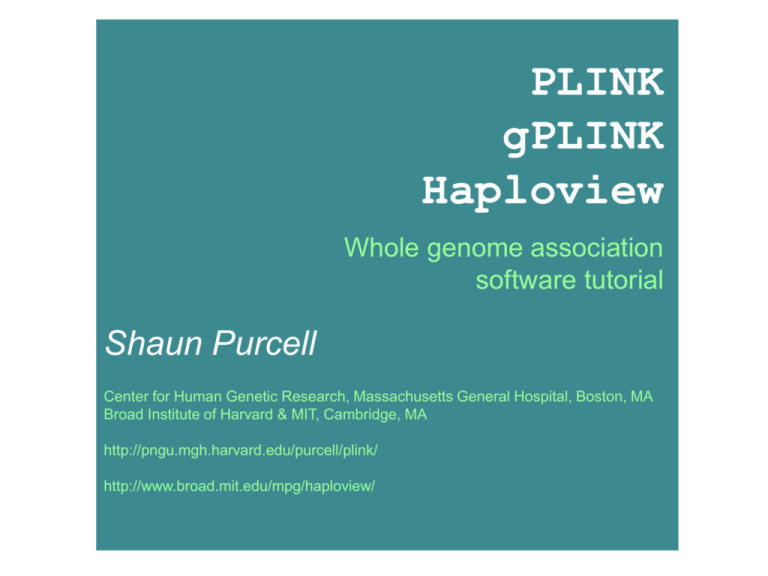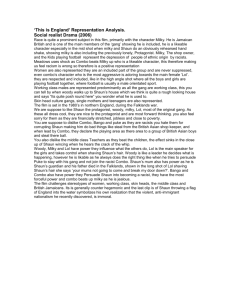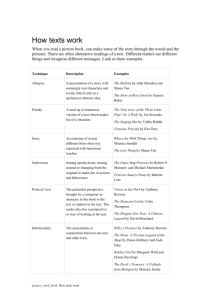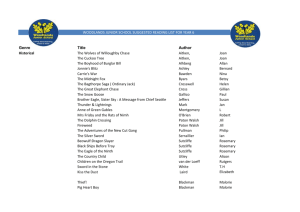practical_gplink - Institute for Behavioral Genetics
advertisement

PLINK gPLINK Haploview Whole genome association software tutorial Shaun Purcell Center for Human Genetic Research, Massachusetts General Hospital, Boston, MA Broad Institute of Harvard & MIT, Cambridge, MA http://pngu.mgh.harvard.edu/purcell/plink/ http://www.broad.mit.edu/mpg/haploview/ PLINK tutorial, December 2006; Shaun Purcell, shaun@pngu.mgh.harvard.edu PLINK tutorial, December 2006; Shaun Purcell, shaun@pngu.mgh.harvard.edu GUI for many PLINK analyses Data management Summary statistics Association analysis Population stratification IBD-based analysis PLINK tutorial, December 2006; Shaun Purcell, shaun@pngu.mgh.harvard.edu Computational efficiency 350 individuals genotyped on 100,000 SNPs Load, filter and analyze ~12 seconds 1 permutation (all SNPs) ~1.6 seconds 5000 individuals genotyped on 500,000 SNPs Load PED file, ~68 minutes generate binary PED file Load and filter binary PED file ~11 minutes Basic association analysis ~5 minutes PLINK tutorial, December 2006; Shaun Purcell, shaun@pngu.mgh.harvard.edu gPLINK / PLINK in “remote mode” Secure Shell networking Server, or cluster head node gPLINK & Haploview: initiating and viewing jobs WWW PLINK, WGAS data & computation PLINK tutorial, December 2006; Shaun Purcell, shaun@pngu.mgh.harvard.edu A simulated WGAS dataset Summary statistics and quality control Whole genome SNP-based association Whole genome haplotype-based association Assessment of population stratification Further exploration of ‘hits’ Visualization and follow-up using Haploview PLINK tutorial, December 2006; Shaun Purcell, shaun@pngu.mgh.harvard.edu Simulated WGAS dataset • Real genotypes, but a simulated “disease” • 90 Asian HapMap individuals – 10K autosomal SNPs from Affymetrix 500K product • Simulated quantitative phenotype; median split to create a disease phenotype • Illustrative, not realistic! PLINK tutorial, December 2006; Shaun Purcell, shaun@pngu.mgh.harvard.edu Specific questions asked 1) What is the genotyping rate? For the most highly associated SNP: 2) How many monomorphic SNPs? 9) Does this SNP pass the Hardy-Weinberg equilibrium test? 3) Evidence of non-random genotyping failure? 4) What is the single most associated SNP? Does it reach genome-wide significance? What is the most associated haplotype? 5) Is there evidence of population stratification from genomic control? 6) Use genotypes to cluster the sample into 2 subpopulations. How well does the clustering recover the known Chinese/Japanese split? 7) Is there evidence for stratification conditional on the two-cluster solution? 10) Does this SNP differ in frequency between the two populations? 11) Is there evidence that this SNP has a different association between the two populations? 12) What are the allele frequencies in cases and controls? Genotype frequencies? What is the odds ratio? 13) Is the rate of missing data equal between cases and controls for this SNP? 14) Does an additive model well characterize the association? What about genotypic, dominant models, etc? 8) What is the best SNP controlling for stratification. Is it genome-wide significant? PLINK tutorial, December 2006; Shaun Purcell, shaun@pngu.mgh.harvard.edu Data used in this practical • Available at http://pngu.mgh.harvard.edu/purcell/affy/purcell.zip example.bed Binary format genotype information (do not attempt to view in a standard text editor) example.bim Map file (6 fields: each row is a SNP: chromosome, RS #, genetic position, physical position, allele 1, allele 2) example.fam Individual information file (first 6 columns of a PED file; disease phenotype is column 6) pop.phe Chinese/Japanese population indicator (FID, IID, population code) qt.phe Alternate quantitative trait phenotype file (Family ID, Individual ID, phenotype) PLINK tutorial, December 2006; Shaun Purcell, shaun@pngu.mgh.harvard.edu The Truth… “11” “12” “22” Chinese Japanese Case 34 7 Case 5 21 23 Control 11 38 Control 16 23 2 Group difference Single common variant rs7835221 chr8 PLINK tutorial, December 2006; Shaun Purcell, shaun@pngu.mgh.harvard.edu A gPLINK “project” is a folder Right-click on the Desktop to create a project folder… …and rename it “project1” PLINK tutorial, December 2006; Shaun Purcell, shaun@pngu.mgh.harvard.edu Copy the relevant files into this folder PLINK tutorial, December 2006; Shaun Purcell, shaun@pngu.mgh.harvard.edu Start a new gPLINK project PLINK tutorial, December 2006; Shaun Purcell, shaun@pngu.mgh.harvard.edu Select the folder you previously created PLINK tutorial, December 2006; Shaun Purcell, shaun@pngu.mgh.harvard.edu Configuring the new project Here, we tell gPLINK… … where the PLINK executable is … specify any PLINK prefixes (advanced option for grid computing) … where the Haploview (version 4.0) executable is … which text editor to use to view files, e.g. WordPad (write.exe) PLINK tutorial, December 2006; Shaun Purcell, shaun@pngu.mgh.harvard.edu Data management • • • • • • • Recode dataset (A,C,G,T → 1,2) Reorder dataset Flip DNA strand Extract subsets (individuals, SNPs) Remove subsets (individuals, SNPs) Merge 2 or more filesets Compact binary file format PLINK tutorial, December 2006; Shaun Purcell, shaun@pngu.mgh.harvard.edu Summarizing the data • • • • Hardy-Weinberg Mendel errors Missing genotypes Allele frequencies • Tests of non-random missingness – by phenotype and by (unobserved) genotype • Individual homozygosity estimates • Stretches of homozygosity • Pairwise IBD estimates PLINK tutorial, December 2006; Shaun Purcell, shaun@pngu.mgh.harvard.edu Validating the fileset Doesn’t do anything, except (attempt to) load the data and report basic statistics Need to enter a unique root filename: Then add a description (for logging) PLINK tutorial, December 2006; Shaun Purcell, shaun@pngu.mgh.harvard.edu Q1) What is the genotyping rate? Clicking on the tree to expand or contract it; individual input or output files can be selected here The log file always gives a lot of useful information: it is good practice always to check it to confirm that an analysis has run okay. Default filters applied here Overall genotyping rate PLINK tutorial, December 2006; Shaun Purcell, shaun@pngu.mgh.harvard.edu Viewing an output file Right-click on a selected file In this case, a list of individuals excluded due to low genotyping rate (just one person here). (A line contains Family ID and Individual ID) PLINK tutorial, December 2006; Shaun Purcell, shaun@pngu.mgh.harvard.edu Filters and thresholds Most forms have Filter and Thresholds buttons Filters exclude people or SNPs based on prespecified lists, or genomic location Thresholds exclude people or SNPs based on genotype data PLINK tutorial, December 2006; Shaun Purcell, shaun@pngu.mgh.harvard.edu Q3) Evidence of non-random genotyping failure? The Summary Statistics/Missingness option can answer this: PLINK tutorial, December 2006; Shaun Purcell, shaun@pngu.mgh.harvard.edu Missing rate in cases (A) and controls (U) and a test for whether rate differs PLINK tutorial, December 2006; Shaun Purcell, shaun@pngu.mgh.harvard.edu Association analysis • Case/control – allelic, trend, genotypic – general Cochran-Mantel-Haenszel • Family-based TDT • Quantitative traits • Haplotype analysis – focus on “multimarker predictors” • Multilocus tests, covariates, epistasis, etc PLINK tutorial, December 2006; Shaun Purcell, shaun@pngu.mgh.harvard.edu Standard association tests Q4) What is the most associated SNP? PLINK tutorial, December 2006; Shaun Purcell, shaun@pngu.mgh.harvard.edu Q5) Evidence of stratification from genomic control? PLINK tutorial, December 2006; Shaun Purcell, shaun@pngu.mgh.harvard.edu Genomic control c2 No stratification ( ) E c2 Test locus Unlinked ‘null’ markers c2 ( ) E c2 Stratification adjust test statistic PLINK tutorial, December 2006; Shaun Purcell, shaun@pngu.mgh.harvard.edu PLINK tutorial, December 2006; Shaun Purcell, shaun@pngu.mgh.harvard.edu PLINK tutorial, December 2006; Shaun Purcell, shaun@pngu.mgh.harvard.edu Haplotype based association Specify a list of specific haplotype tests (*.hlist file) Q4b) What is the most associated haplotype? PLINK tutorial, December 2006; Shaun Purcell, shaun@pngu.mgh.harvard.edu Specifying haplotype tests Specify specific haplotypes Predictors Predicted ID chr cM bp alleles i_rs2906364 8 0 158484 1 2 i_rs3750097 8 0 187042 1 2 i_rs10105400 8 0 188546 1 2 i_rs13258954 8 0 211039 1 2 … etc … Haplotype SNPs (in data file) 14 rs7000519 rs10488370 23 rs2906334 rs11988064 23 rs2906334 rs11988064 34 rs13265571 rs3008257 Or, specify the locus (i.e. only specify predicting SNPs) * * * … rs7000519 rs10488370 rs2906334 rs11988064 rs2906334 rs13265571 rs3008257 etc … Or, specifying a sliding window of fixed SNPs with: e.g. --hap-window 4 PLINK tutorial, December 2006; Shaun Purcell, shaun@pngu.mgh.harvard.edu Haplotype-based tests Haplotype C/C association results (omnibus & haplotype-specific) List of tests that could not be performed, e.g. if the predictor SNPs were removed in the filtering stage PLINK tutorial, December 2006; Shaun Purcell, shaun@pngu.mgh.harvard.edu Identity-by-state (IBS) sharing Pair from same population Individual 1 A/C | Individual 2 C/C IBS 1 G/T | T/T 1 Pair from different population Individual 3 A/C G/G | Individual 4 C/C T/T IBS 1 0 A/G | | A/G 2 A/A A/A A/A G/G 0 C/C 0 C/C 0 G/G | | G/G 2 G/G | A/G 1 PLINK tutorial, December 2006; Shaun Purcell, shaun@pngu.mgh.harvard.edu Empirical assessment of ancestry Han Chinese Japanese Complete linkage IBS-based hierarchical clustering Multidimensional scaling plot: ~10K random SNPs PLINK tutorial, December 2006; Shaun Purcell, shaun@pngu.mgh.harvard.edu Q6) Use genotypes to cluster the sample into 2 subpopulations Step 1) Generate IBS distances for all pairs (may take a few minutes) PLINK tutorial, December 2006; Shaun Purcell, shaun@pngu.mgh.harvard.edu Step 2) Cluster individuals based on IBS distances and other constraints Specify previously-generated IBS file (*.genome) Constrain cluster solution to two classes (K=2) PLINK tutorial, December 2006; Shaun Purcell, shaun@pngu.mgh.harvard.edu PLINK tutorial, December 2006; Shaun Purcell, shaun@pngu.mgh.harvard.edu PLINK tutorial, December 2006; Shaun Purcell, shaun@pngu.mgh.harvard.edu Stratified analysis • Cochran-Mantel-Haenszel test A B A B C A D B C A D B C AD B C D C D • Stratified 2×2×K tables PLINK tutorial, December 2006; Shaun Purcell, shaun@pngu.mgh.harvard.edu Select the previously calculated *.cluster2 file. This “cluster file” has one line per individual PLINK tutorial, December 2006; Shaun Purcell, shaun@pngu.mgh.harvard.edu Q7) Evidence of stratification conditional on cluster solution? PLINK tutorial, December 2006; Shaun Purcell, shaun@pngu.mgh.harvard.edu Q8) What is the best SNP controlling for stratification? PLINK tutorial, December 2006; Shaun Purcell, shaun@pngu.mgh.harvard.edu Making a Haploview fileset Select 200kb region around our “best hit” PLINK tutorial, December 2006; Shaun Purcell, shaun@pngu.mgh.harvard.edu PLINK tutorial, December 2006; Shaun Purcell, shaun@pngu.mgh.harvard.edu PLINK tutorial, December 2006; Shaun Purcell, shaun@pngu.mgh.harvard.edu PLINK tutorial, December 2006; Shaun Purcell, shaun@pngu.mgh.harvard.edu PLINK tutorial, December 2006; Shaun Purcell, shaun@pngu.mgh.harvard.edu PLINK tutorial, December 2006; Shaun Purcell, shaun@pngu.mgh.harvard.edu In the remaining time (if any…) • Extract as a new PLINK fileset just the single best SNP (rs7835221) • Using this new file, attempt questions 9-14. – Here are some clues • • • • • 9) Summary statistics → Hardy Weinberg 10) Standard association test, with an alternate phenotype 11) Stratified association with Breslow-Day test 12) You’ve already calculated these (i.e. *.assoc, *.hwe) 13) This is already calculated also (i.e. *.missing) • 14) Use genotypic association test Consult the PLINK documentation (http://pngu.mgh.harvard.edu/purcell/plink/) PLINK tutorial, December 2006; Shaun Purcell, shaun@pngu.mgh.harvard.edu In summary • We performed whole genome – summary statistics and QC – stratification analysis – conditional and unconditional association analysis • We found a single SNP rs7835221 that… – is genome-wide significant – has similar frequencies and effects in Japanese and Chinese subpopulations – shows no missing or HW biases – is consistent with an allelic, dosage effect – has common T allele with strong protective effect ( ~0.05 odds ratio) PLINK tutorial, December 2006; Shaun Purcell, shaun@pngu.mgh.harvard.edu Acknowledgements Haploview development (g)PLINK development Julian Maller Shaun Purcell Dave Bender Jeff Barrett Mark Daly Kathe Todd-Brown Ben Neale Mark Daly Pak Sham PLINK tutorial, December 2006; Shaun Purcell, shaun@pngu.mgh.harvard.edu







